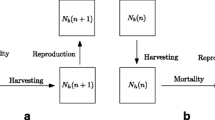Abstract.
The role of harvest in discrete age-structured one-population models has been explored. Considering a few age classes only, together with the overcompensatory Ricker recruitment function, we show that harvest acts as a weak destabilizing effect in case of small values of the year-to-year survival probability P and as a strong stabilizing effect whenever the survival probability approaches unity. In the latter case, assuming n=2 age classes, we find that harvest may transfer a population from the chaotic regime to a state where the equilibrium point (x1*, x2*) becomes stable. However, as the number of age classes increases (which acts as a stabilizing effect in non-exploited models), we find that harvest acts more and more destabilizing, in fact, when the number of age classes has been increased to n=10, our finding is that in case of large values of the survival probabilities, harvest may transfer a population from a state where the equilibrium is stable to the chaotic regime, thus exactly the opposite of what was found in case of n=2. On the other hand, if we replace the Ricker relation with the generalized Beverton and Holt recruitment function with abruptness parameter larger than 2, several of the conclusions derived above are changed. For example, when n is large and the survival probabilities exceed a certain threshold, the equilibrium will always be stable.
Similar content being viewed by others
References
Anon: Advisory Committee on Fisheries Management (ACFM): Report of the Arctic Fisheries Working Group. ICES CM 2001/ACFM:19, 2001
Bergh, O., Getz, W.M.: Stability of discrete age-structured and aggregated delay-difference population models. J. Math. Biol. 26, 551–581 (1988)
Bogstad, B.: Multispecies models for the Barents Sea. Dr. Scient. thesis, University of Bergen, Bergen, Norway, 1997
Caswell, H.: Matrix Population Models. Sinauer Ass. Inc. Publishers, Sunderland, Massachusetts, 2001
Crowe, K.M.: A nonlinear ergodic theorem for discrete systems. J. Math. Biol. 32, 179 –191 (1994)
Cushing, J.M.: Nonlinear matrix models and population dynamics. Nat. Resour. Model 2, 539–580 (1988)
Cushing, J.M.: A strong ergodic theorem for some nonlinear matrix models for the dynamics of structured populations. Nat. Resour. Model 3, 331–356 (1989)
Cushing, J.M., Dennis, B., Desharnais, R.A., Costantino, R.F.: An interdisciplinary approach to understanding nonlinear ecological dynamics. Ecol. Model 92, 111–119 (1996)
Cushing, J.M., Costantino, R.F., Dennis, B. Desharnais, R.A., Henson, S.M.: Nonlinear population dynamics: Models Experiments and Data. J. Theor. Biol. 194, 1–9 (1998)
Costantino, R.F., Desharnais, R.A., Cushing, J.M., Dennis, B.: Chaotic dynamics in an insect population. Sci. 275, 389–391 (1997)
Cooke, K.L., Elderkin, R., Witten, M.: Harvesting procedures with management policy in iterative density-dependent population models. Nat. Resour. Model 3, 383–421 (1988)
DeAngelis, D.L., Svoboda, L.J., Christensen, S.W., Vaughan, D.S.: Stability and return times of Leslie matrices with density-dependent survival; Applications of fish populations. Ecol. Model 8, 149–163 (1980)
Dennis, B., Desharnais, R.A., Cushing, J.M., Costantino, R.F.: Transition in population dynamics: equilibria to periodic cycles to aperiodic cycles. J. Animal Ecol. 6b, 704–729 (1997)
Davydova, N.V., Diekman, O., van Gils, S.A.: Year class coexistence or competitive exclusion for strict biennials? J. Math. Biol. 46, 95–131 (2003)
Flaaten, O.: The Economics of Multispecies Harvesting. Springer Verlag, Berlin, Heidelberg, New York, London, Paris, Tokyo, 1988
Getz, W.: A hypothesis regarding the abruptness of density dependence and growth rate of populations. Ecology 77, 2014–2026 (1996)
Getz, W.M., Haight, R.G.: Population Harvesting. Princeton Press, 1989
Guckenheimer, J., Oster, G., Ipaktchi, A.: The dynamics of density dependent population models. J. Math. Biol. 4, 101–147 (1977)
Guckenheimer, J., Holmes, P.: Nonlinear Oscillations, Dynamical Systems, and Bifurcations of Vector Fields. Springer Verlag, Berlin, Heidelberg, New York, Tokyo, 1990
Levin, S.A.: Age-structure and stability in multiple-age spawning populations. Renewable Resource Managements, eds. Vincent T.L. and Skowronski J.M. Springer Verlag, Heidelberg, 1981
Levin, S.A., Goodyear, P.H.: Analysis of an age-structured fishery model. J. Math. Biol. 9, 245–274 (1980)
Murray, J.D.: Mathematical Biology. Springer Verlag, Berlin, Heidelberg, New York, 1993
Penman, S.H.: Financial Statement. Analysis and Security Valuation. McGraw-Hill, International Edition, 2001
Schoombie, S.W., Getz, W.: Evolutionary stable strategies and trade-offs in generalized Beverton and Holt growth models. Theor. Population Biol. 53, 216–235 (1998)
Shepherd, J.G.: A versatile new stock-recruitment relationship for fisheries, and the construction of sustainable yield curves. Journal du Conseil International pour l’Exploration de la Mer 40, 67–75 (1982)
Silva, J.A., Hallam, T.G.: Compensation and stability in nonlinear matrix models. Math. Biosci. 110, 67–101 (1992)
Silva, J.A., Hallam, T.G.: Effects of delay, truncation and density dependence in reproduction schedules on stability of nonlinear Leslie matrix models. J. Math. Biol. 31, 367–395 (1993)
Spiegel, M.R.: Complex Variables. McGraw-Hill Book Company, 1974
Tuljapurkar, S., Boe, C., Wachter, K.W.: Nonlinear feedback dynamics in fisheries: Analysis of the Deriso–Schute model. Can. J. Fish. Aquat. Sci. 51, 1462–1473 (1994)
Wikan, A., Mjølhus, E.: Periodicity of 4 in age-structured population models with density dependence. J. Theor. Biol. 173, 109–119 (1995)
Wikan, A., Mjølhus, E.: Overcompensatory recruitment and generation delay in discrete age-structured population models. J. Math. Biol. 35, 195–239 (1996)
Wikan, A.: Dynamic consequences of reproductive delay in Leslie matrix models with nonlinear survival probabilities. Math. Biosci. 146, 37–62 (1997)
Wikan, A.: From chaos to chaos – An analysis of a discrete age-structured prey–predator model. J. Math. Biol. 43, 471–500 (2001)
Author information
Authors and Affiliations
Corresponding author
Additional information
Revised version: 18 September 2003
Rights and permissions
About this article
Cite this article
Wikan, A. Dynamical consequences of harvest in discrete age-structured population models . J. Math. Biol. 49, 35–55 (2004). https://doi.org/10.1007/s00285-003-0251-5
Received:
Published:
Issue Date:
DOI: https://doi.org/10.1007/s00285-003-0251-5




